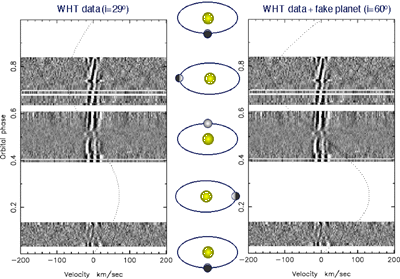|
WHT Achieves
First Direct Detection of an Extra-solar Planet
This grayscale phase
plot illustrates the method of Cameron et al. for detecting reflected-light
signatures from extra-solar planets, using data secured with the WHT +
UES in 1998 and 1999. The left-hand panel shows 145 residual velocity profiles
of the tau Boo system, obtained by subtracting a model of the direct starlight
from the data and averaging the profiles of the ~2300 spectral lines buried
in the residual spectrum. The velocity scale is in the reference frame
of the star, and time increases upward. The dotted paths indicate the velocity
curve of a planet orbiting with an orbital inclination of 29° (left-hand
panel) and 60° (right-hand panel). The right-hand panel shows the effect
of adding the simulated spectrum of a planet with 1.4 Jupiter radii and
Jupiter-like reflectivity to the original spectra. The simulated planet
signature appears as a dark linear feature with an amplitude about 10–4
of the mean stellar continuum level, crossing from positive to negative
velocity at phase 0.5 when the planet is on the far side of the star. The
planetary signature detected in the data is much weaker, because of the
low inclination, but would follow the velocity curve shown in the left-hand
panel. The "barber's pole" pattern of travelling ripples lies wholly within
the residual stellar profile, is wavelength independent, and probably originates
in stellar surface features (see article by Andrew Collier
Cameron). [ GIF | TIFF
] |
